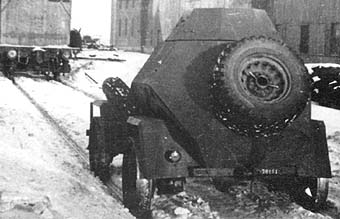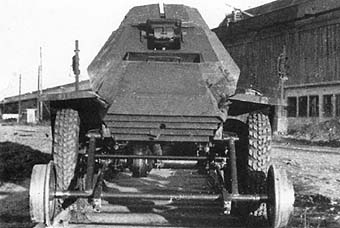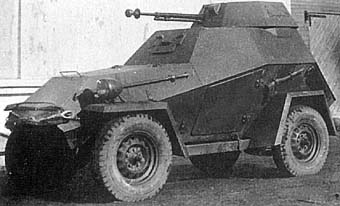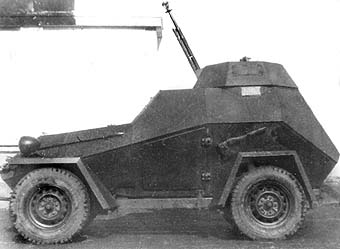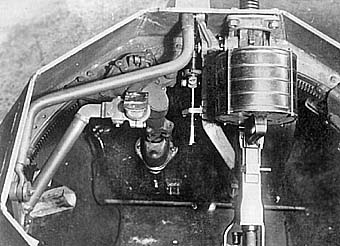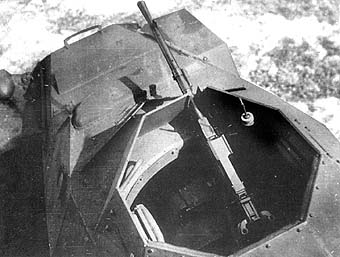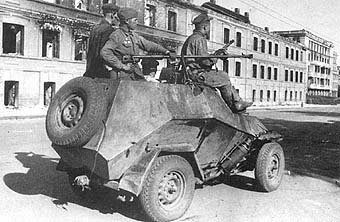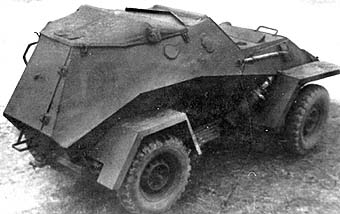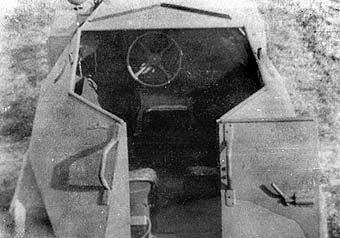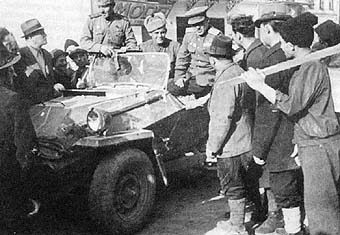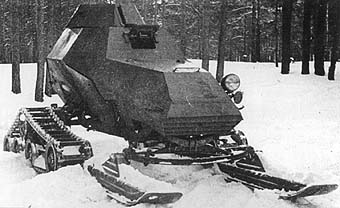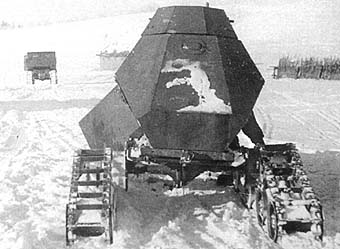| Language |
|---|
| Google Translation |
|---|
|
|
| Main Resources | |||||||||
|---|---|---|---|---|---|---|---|---|---|
|
| Additional Stuff | ||||
|---|---|---|---|---|
|
| Online Services | ||
|---|---|---|
|
| Miscellaneous | |||||||
|---|---|---|---|---|---|---|---|
|
| Private messages |
|---|
|
You are not logged in. |
| Log in |
|---|
 |
| Users online |
|---|
| We have 330 guests online |
| Search |
|---|

| Modifications of the BA-64 |

|

|
Modifications of the BA-64BA-64VSimultaneously the mass production of the BA-64, both factories has continued the improvement of this armored car. To use it as armored trolley and convoy the rail echelons, there were several attempts to put it onto rail tracks. First attempt (in July 1942) was undertaken by the Vyksunskiy Factory. Using the stored quantity of the rail wheels, which have remained from the days of BA-20ZhD's manufacturing (the abbreviation "ZhD" means "Zheleznodorozhniy" or railway), the factory made the rail modification of the BA-64.
It is important to say, that the chassis of the armored car was slightly changed because its track was more narrow than on the BA-20ZhD, thus it couldn't be installed on the railway without of some corrections. The narrow track was compensated by longer axes, which led to faster deterioration of the roller bearings. Nevertheless, the BA-64 was modernised and, in December 1942, the modernised BA-64V ("V" means "Vyksunskiy") was sent to the trials. The total weight increased to 2586 kg. The trials revealed some other disadvantages: the reverse speed was only 13 km/h (the reverse of the BA-20ZhD was 27 km/h). That was especially bad because the usage as rail trolley supposed the movement with equal speeds in both directions. Initially, BA-64 was designed as armored car, not as locomotive and, as a result, another two disadvantages were found. First problem was with its gearbox: it wasn't designed for a long reversible work, thus it often broke. The second problem was with cooling of the engine: it was of air-cooling, and thus, during the backward movement it didn't receive a proper coolness and quickly overheated. From the other hand, such way of modernisation was the easiest and, without a doubt, the cheapest. BA-64G
Simultaneously with the Vyksunskiy's attempts to develop an armored trolley, the same works were undertaken on the GAZ Factory. Unlike the BA-64V, the engineers of the GAZ have decided to develop an universal vehicle, which could move both on road wheels and rail wheels. Their variant - BA-64G ("G" means "Gorkovskiy") - represented the common BA-64 that was equipped with additional (removable) four rail wheels as shown on photos. To drive down from the railway, crew should raise the rail wheels. The backward movement was provided by a special reversible distribution box. In November 1942, the first BA-64G was manufactured and the very first trials were undertaken. Unfortunately they have failed: during the installation on the railway, both axes of the rail wheels were bent. Subsequent trials revealed the instability during the movement and frequent falls from the rail track. That was because of small diameter of the rail wheels. Because of this, further trials were cancelled until the improvement of all discovered defects won't be done. From January 12, 1943, the trials continued with improved variant of the BA-64G. In spite of all improvements, the discovered defects still existed. As before, there were frequent falls from the railway and frequent engine's overheat (during the frosty winter!). The experiments with the BA-64G have continued until the summer 1943, when they was cancelled at all. At that moment totally three BA-64G's were manufactured. The BA-64D
The insufficient firepower of the 7.62 mm Degtyarev's machine-gun revealed from the very first battles. It forced designers to find ways to rearm the BA-64 with a more powerful weapon. At that time, the most perspective way seemed to rearm it with the 12.7 mm DShK heavy machine-gun. That was the very reliable HMG, it received many positive responses from regular army. Moreover, it had a very quality ammunition, which was already set up in a mass production. The idea was conform and further modification received the "BA-64D" designation (the "D" means "DShK"). For the very first time (September 23, 1942) designers tried just to replace the DT TMG with the DShK HMG, without any major changes. They have "modernised" the narrow-track BA-64. Next day, they had showed the vehicle to N.A.Astrov, who was pleased with the "new" vehicle and offered some valuable ideas. Nevertheless, the "simple" rearming the BA-64 with such a powerful weapon was impossible and has supposed to add a definite improvements in construction in both BA-64 and DShK. The turret's support should been strengthened due to the big weight of the DShK (34 kg) and its big recoil force. Besides, the special K-8T sight was added for antiaircraft shooting. For a ground targets there was a standard TMFP telescopic sight. All these improvements were so serious that the cost price of the turret has raised dramatically. The turret's traversing mechanism contained some elements from the same mechanism of the T-60 light tank. The main difference was that the turret of the BA-64D could be traverced both manually and mechanically. Among the other changes, the thickness of the armor of the turret was increased up to 12 mm, which was important for the safe installation of the DShK. The first BA-64D with the new turret and armed by the DShK was manufactured by the March 20, 1943. From April 4, 1943, the trials of that armored car begun on the Striginsky proving ground. The full weight of the BA-64D was 2425 kg.
On April 6, the BA-64D was showed to General A.I.Lebedev and General I.P.Telegin. That show was failed due to defects of the modernised DShK. During the shooting, the rounds are jamming because of new magazine, the used cartridges are jamming too. Moreover, that magazine was too small - 30 rounds only! Because of big recoil of the DShK and a narrow track of the BA-64, the machine-gun accuracy was far from perfection if the HMG was perpendicular towards the axis of the vehicle. Nevertheless, on April 12, 1943, the BA-64D was sent in Moscow for showing to the High Command of the Tank Forces of the Red Army. The HQ also noticed all imperfections of the magazine: small capacity, inaccurate design. The HQ recommended to use the steel cartridge belt instead of magazine. However, that was incorrect decision as well because of insufficient space in the turret. So, the GAZ refused that. As a result, the whole project to rearm the BA-64 with a DShK was abandoned. BA-64 with SG-43 Machine-Gun
The appearance of the new, more powerful 7.62 mm machine-gun of the Gorunov's design (SG-43), renewed the idea to rearm the BA-64B. Weighing the 13.8 kg, the SG-43 had the maximum range 2000 metres. It is important to say, by that time all attempts to rearm the BA-64/BA-64B were failed due to different reasons. From March 3, 1944, the works on rearming of the BA-64B started. There was a single attempt. The SG-43 was installed instead of DT, without any changes in construction of the turret, like the very first BA-64D. The SG-43 was longer than the DT, but anyway, it was placed in the standard turret. I must say, that the such "simple" installation of the SG-43 reduced the horizontal sector of fire (without traversing the turret). In April 1944 the BA-64B with the new armament was sent to the proving ground. The trials were unsuccessful. The SG-43 was luck of humeral support which resulted a low accuracy. There were some difficulties of reloading the machine-gun. After the trials, the new armored car was not recommended for service. All further works were cancelled. BA-64 with an antitank rifle
In December 1942, the GAZ had tried to rearm the BA-64 with the 14.5 mm self-loading Simonov's antitank rifle (PTRS). It supposed, that it would increase the firepower of the armored car, so BA-64 would be move valuable in offence and defense. Because of big recoil force of the PTRS, this AT rile was installed into the turret with the specially designed anti-recoil mechanism (shock-absorber). For the some time, the works on this modification were delayed in favor of BA-64D, but in March 1943 they were resumed. Judging by GAZ's archive documents, there were attempts to modernise the PTRS to increase the current magazine capacity (standard PTRS had five-loading magazine) as well as automate the fire of the rifle (by removing the disconnector). However, all those works were abandoned, the reasons are not clear for me yet. Anyway, in the regular army there were sporadic "home-made" conversions with both PTRS and PTRD antitank rifles. BA-64E (BASh-64)
The success of the German APCs forced the Soviet constructors to develop a transport variant of the BA-64. Frankly, BA-64 was the worst base for the such works however, at that time there weren't any alternatives. It was supposed that further vehicle will be without a turret and would be open from the top, but the hull will be remained. On October 22, 1942, the first test were made. At the rear hull the door was made, the roof remained only over the driver. The new 55-litres fuel tank was relocated to the left side and put under the bench. New vehicles supposed to be armed with the 7.62 mm Degtyarev's machine-gun. Further works over the APC have been delayed until the March 1943. At that time the second variant was built. It received the BA-64E designation. The short trials revealed the main disadvantage: it was a quite hard to leave the vehicle.
At the mid-March, the third variant of the BA-64E was built. It had better crew (6 men) layout. By the 3rd April, the next, fourth variant was built. It was based on BA-64B. The sides were higher and the pair embrasures were made from the each side. The DT was removed at all, however the question about armament of the BA-64E has discussed for a quite long time and there were attempts to arm the BA-64E with the light 37-mm ChK-M-1 gun. By the end 1943, GAZ manufactured three BA-64E and sent them to the regular army for a detailed trials. Two vehicles were sent to the 3rd Guards Tank Army, and one BA-64E - to the 7'th Mechanized Corps. Both units returned a negative response: too cramped, too uncomfortable. Using their response, GAZ produced another three APC's. Now, each APC could carry 4 infantrymen. On September 28, 1943, they have been showed to the Marshal J.N.Fedorenko. He offered to add some changes. GAZ agreed and produced another three APC's with a various realization of the Fedorenko's recommendations. After that they have been showed to Fedorenko again. He chose one of them and offered to install the powerful radio 12-RTM. As the result, the new staff vehicle has been created. After the minor improvements that vehicle was showed to a special commission of the Tank Forces of the Red Army. In some literature, that vehicles named BASh-64 ("Sh" means "shtabnaya" - staff), but I've never seen that designation in archive documents. In spite of positive responses of that commission, that modification was not accepted for service. The reason was simple: the war ended faster then the first produced vehicle reached the frontline. The BA-64Z
Trying to solve a problem of truck's movement over a snowy terrain in winter 1942 the new truck GAZ-SKh was developed (it was based on the chassis of the GAZ-AA). Instead of common wheels, the truck had the original track unit which has been developed before the Great Patriotic War (Chief-engineer - S.S.Nezhdanovsky). The driving-wheels were replaced with track unit, the front wheels were replaced with pair of a wide skis. Then, the idea to install the BA-64 onto Nezhdanovsky's track unit suggested. From July 1943, the works on this idea started. The very first prototype was finished by January 1944. New vehicle received the BA-64Z designation ("Z" means "zimniy" - winter). The brakes, absorbers, the driving shaft, distribution box and the reserve wheel were removed from the new vehicle. The overall dimensions of the BA-64Z increased: length - 4560 mm, width - 2280 mm, height - 2020 mm. The full weight increased up to 2980 kilos. On January 9, 1944, the first trials begun, but finished unsuccessfully: the BA-64Z stuck. It was dragged out by the GAZ-62 truck. From January 13, the trials resumed, now the BA-64Z towed the field gun. (Unfortunately, the report does not clarify the model, just mentioned "a field gun". The 76-mm ZIS-3 field gun seems to me most likely however). The BA-64Z run very well, but fell into the ditch and damaged the skis. From January 30 to February 10, 1944, the BA-64Z successfully passed the overall trials. The average speed on the hilly snowy terrain was 7.6 km/h, on the firm road - 16 km/h. The maximum theoretical speed - 28 km/h - was nor achieved because of weak engine. The car run with a big difficulties over the non-snowed flat terrain, and could not pass the hills at all if they weren't covered by snow. The tracks often collapsed. BA-64Z used too many fuel: from 1.2 to 1.5 litres per kilometer. Trials revealed another big problem of the BA-64Z: a quite low maneuverability. That was especially bad for wooded country, sometime it was need to saw off a tries to get a path. Because of these serious problems, the BA-64Z was considered as hopeless and all further works were cancelled.
|
|||||||||||
Discuss this item on the forums. (0 posts)
|
© The Russian Battlefield, 1998 Webdesign: |



